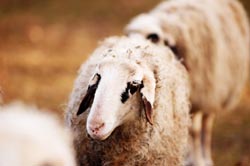Genetics of sheep milkability
Sheep milk can no doubt be utilised as a nutritional food. More acceptable to the human digestive system, sheep milk is not as strong as goat's milk, and its flavour may be more suitable for children. With an abundant supply available, this resource is only beginning to be tapped. Possible products include powdered products, cheese (France's Roquefort and traditional Greek Feta being two good examples) and related protein supplements. The appropriately named European project, GENESHEEPSAFETY conducted research into the safety and quality of sheep products. The emphasis was placed on the use of breeding programmes to achieve its aims. In the quest for high milk yield, the research team at the Istituto Zootecnico e Caseario per la Sardegna in Italy endeavoured to identify quantitative loci (QTL) involved in two traits. These were udder morphology and milk emission during machine milking. In order to study udder morphology, basic udder traits such as teat placement were scored on a linear basis and digital photographs were also used to make objective measurements. For milk emission, a measuring device for milk flow was fitted on the machine. The results showed that moment of maximum milk flow (MMF) and latency time (LT) were the most pertinent factors for measuring milking speed. Using data collected over three years that was adjusted for environmental effects, detection of QTLs using QTLmap software was performed. Notably, the team adopted a novel approach regarding the investigation of correlated traits. Overall, over 50 significant locations throughout the sheep genome for udder morphology were detected. The importance of various traits important for milking was taken into account. For example, cistern height, or height of the reservoir where the milk is stored, is crucial in order to obtain all the milk available. These results represent the first step in the genetic analysis of milkability on dairy ewes. Development of breeding programmes based on these studies could be instrumental in the reduction of chemical inputs against bacteria that cause mastitis. This represents an important contribution in the drive towards improved health for sheep and quality of their products.







